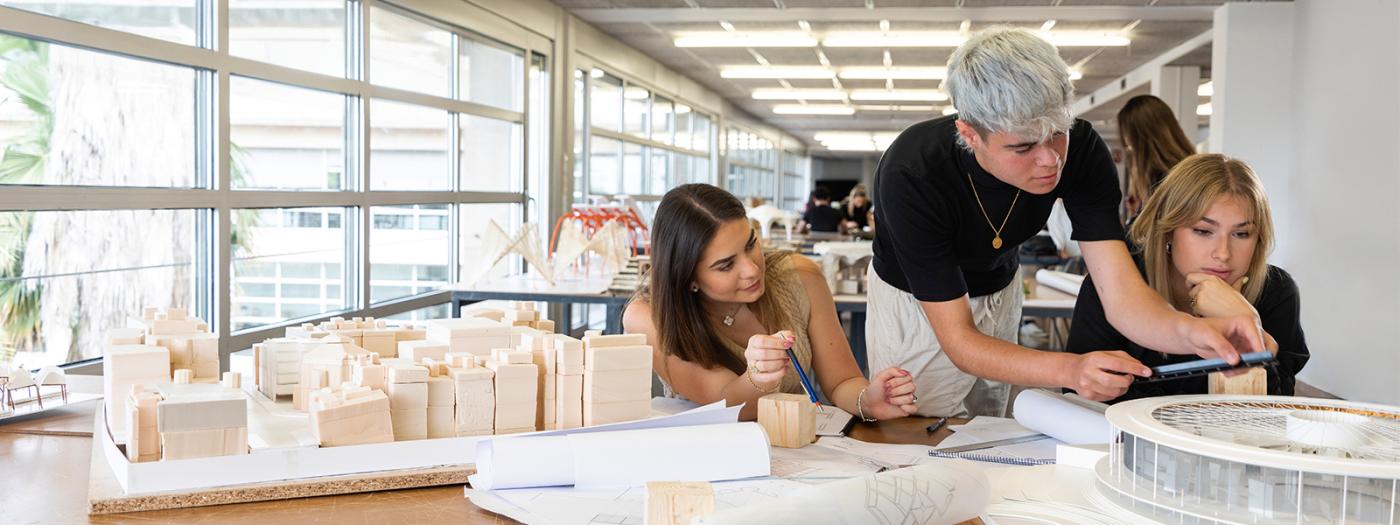A basic general knowledge of Building.
The ability to use a computer and the CAD programmes.
Students who complete the course on `Wooden structures, wooden constructions, acquire the knowledge and develop the skills listed below:
1. The knowledge of dry framework construction, basically of wooden structures, with respect to the practice of the architectural profession.
2. To identify, formulate and resolve problems of comfort, solidity and aesthetics.
3. To comprehend the impact of the sustainable construction on society and the importance of working in a professional environment and being ethically correct.
4. To use the latest techniques and tools in the most advanced construction forms.
1. The material. Features of wood.
1.1. The composition of wood. Its macroscopic and microscopic structures.
1.2. Physical properties. Dampness, durability, inflammable values, combustion.
1.3. Mechanical properties. Elasticity, flexibility, hardness, shock-resistence, compression strength, traction, cutting and flexion, warpness, erosion.
1.4. Limitations caused by defects of the wood itself: knots, splits
.
1.5. Classification of wood. Characteristics and applications of luxuriant and conifer trees,
2. The pathologies of wood in general. Prevention and causes of damage. Repair of elements and rehabilitation of structures.
2.1. Abiotic degradation factors. UV radiation, dampness, fire, chemical damage.
2.2. Biotic degradation factors. Fungi and insects.
2.3. Structural Behavioural degradation factors. Splits, breaks and deformations caused by force.
2.4. How to Project wood in modern constructions. Protection treatments for surface and below.
2.5. Repair of constructions in rehabilitation. Treatment cures for elements which have been degraded either abiotically or biotically.
2.6. Research systems for structural problems. Support or substitution of structural elements.
2.7. Complete rehabilitation of wooden structures. Bending of forms and consolidation.
3. The construction methods. Typologies of wooden constructions.
3.1. Description of the elements. Beams and pillars, small windows and joints. Brackets and division methods. The light framework of the construction model.
3.2. The construction with wood as a sustainable technique.
3.3 The exploitation of re-forestation.
3.3. List of conditionals and quality control of wood.
3.4. Mixed structures used for pre-fabricated walls and wooden ceilings. Evolution of traditional systems and new mixed techniques.
3.5. Light framwork method (`Platform frame´). Development of a building, the Project, the
record, a list of the conditions of the specific elements of wood. Models and graphic representation.
3.6 Special panels and iron work. Preconstruction system of new wooden buildings. Light panels and integral systems.
3.6. Laminated wood. Porticos. Comparison of the structural aptness of wood, concrete and metallic structures.
4. Calculating the wooden structure.
4.1. Calculation rules. The classification of chipboard, laminated wood and plasterboards. The importance of the stamp of quality.
4.2. The structural behaviour of the light framework (`platform´). Difuse structure of minor elements. Stability of the building using horizontal and vertical frames. The role of structural plasterboard.
4.3. Calculation of the elements (beams, joints, supports). Difference between the permanent loads and the instantaneous ones.
4.4. Calculation of laminated wood porticos. The problems of big lights and big supports. The stability of the structure against horizontal forces.
4.5. Predimensioned criteria of light wooden frameworks. The importance of the model in the calculation.
4.6. Estimation of the strength of wood in rehabilitation work. Recognition of how the structure works identification of the type of wood and its strength. The calculation of the existing structural element.
Lectures in the given timetable. The students research and widen their knowledge outside the classroom following the instructions of the teacher.
Capacity to analyse and synthesize.
Effective oral and written communication in her/his own language.
Basic computing skills.
A. Exams
Punctuation:- 80% wooden structures - 20% structures
Objective 1:
● The student must demonstrate her/his knowledge of dry, lightweight construction, basically wood, with respect to the practice of the architectural profession. [A].
Objective 2:
- The student must show her/his ability to identify, formulate and resolve problems of comfort, solidity and aesthetics. [A].
Objective3:
● The student must show her/his comprehension of the impact of the sustainable construction on society and the importance of working in a professional environment and being ethically correct. [A].
Objective 4:
- The student must show his/her ability to use the latest techniques and tools in the most advanced construction forms. [A].
Francisco Arriaga; Xavier Casanovas; Ario Ceccotti; Guglielmo Giordano; Ramon Graus; Joaquín Montón; Ángeles Navarrete; Liliana Palaia; Felice Regazzo; Gennaro Tampone; Luca Uzielli. `Manual de diagnosi, patologia i intervenció en estructures de fusta´. Col-legi d´Aparelladors i Arquitectes Tècnics de Barcelona. Febrero de 1995.
Naomi Stungo. `The new wood architecture´. Seuil. 1998.
Peraza Sánchez, José Enrique; Arriaga Martitegui, Francisco; Arriaga, Carmen; Martitegui; González Álvarez, Marco Antonio; Peraza Sánchez, Fernando; Rodríguez Nevada, Miguel Ángel. `Casas de Madera´. Asociación de Investigación Técnica de las Industrias de la Madera y Corcho (AITIM). 1995.
Arriaga Martitegui, Francisco; González Alvarez, Marco A.; Medina Gallego, Gonzalo; Ortiz Gutiérrez, Jaime; Peraza Sánchez, Fernando; Peraza Sánchez, J. Enrique; Touza Vázquez, Manuel C. `Guía de la Madera´. AITIM. 1994.
`Revista Bulletin bois´. Lignum. Trimestral. info@lignum.ch
`Revista Tectónica´. Núm. 11 i 13. ATC Ediciones S.L.
Revista 2G. `Casas americanas MARCEL BREUER´. G GILI
